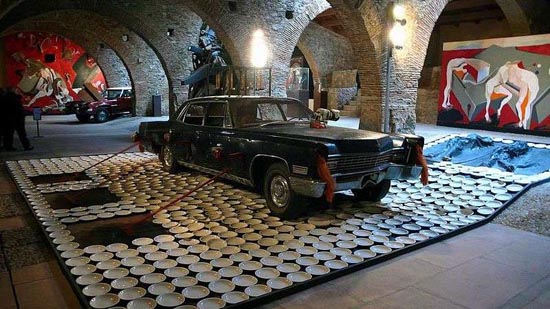Situated a short distance outside of the city of Cáceres in Extremadura, Spain, is a fascinating and unique art museum.
German artist Wolf Vostell has turned an 18th century wool washing house into a strange and unusual artistic display.
Vostell is one of the early associates of what is called the “Fluxus" movement. This group has explored using various different techniques, blending noise and music, video and design with more typical artistic mediums to create something different. The word “Fluxus" comes from the Latin word, meaning "flux" or "flow," and this artistic work certainly flows, if in a very unusual way.
Stork art by Francisco Mingorance. Storks nesting on sculpture outside Vostell-Malpartida Museum, Spain.— Katharine Francis (@KatharineTace) September 7, 2015
V @NHM_WPYpic.twitter.com/MOBBb2paXN
Vostell (1932-1998) took over the building, situated in the Los Barruecos de Malpartida natural park, in 1976 and created an avant-garde and fascinating exhibition which joins together life, nature and art. The three big collections inside the building cover a floor space of approximately 14,000 square meters. One is the "Wolf and Mercedes Vostell Collection," which is covered in this article, and the other two are the "Fluxus Donation Gino di Maggio Collection" and the "Conceptual Artists' Collection."
Highly representative of Vostell's work, the installation uses cars to make up several different displays, including "Auto Fever (1973)," the totally fascinating "Fluxus Buick Piano," which can be seen in the video included below, and "Breakfast of Leonardo da Vinci in Berlin in 1998."
Highly representative of Vostell's work, the installation uses cars to make up several different displays, including "Auto Fever (1973)," the totally fascinating "Fluxus Buick Piano," which can be seen in the video included below, and "Breakfast of Leonardo da Vinci in Berlin in 1998."
Descobrindo Cáceres - Malpartida de Caceres - Museu Vostell ... https://t.co/pZxGdlEAFO pic.twitter.com/39oUC4MtMB— Os Papa Trilhos (@nenucopastelita) July 15, 2016
It is difficult to describe the awesome surrounding sound, colors and images that are seen on viewing Vostell's installations. He has combined the old cars with sound and television, using the Fluxus technique, to create an amazing experience, which according to Vostell defines our current society.
As one walks through the museum, televisions screen videos, closely tied to that particular exhibit, and the often discordant sounds surround a visitor, taking them almost to another world. The experience brings to mind science fiction films of recent years, featuring future dystopian societies, with a little chaos in the background.
There are also several sculptures by Vostell in the grounds surrounding the museum, including one 16-meter creation (above) which was created using the remains of a Russian Mig-21 aircraft, in combination with two cars, three pianos and several computer monitors (pictured bottom of article). The name of this creation is “Why Did the Process Between Pilate and Jesus Last Only Two Minutes?” Close by is a second sculpture called “Car in Concrete.”
The Vostell Malpartida Museum in Cáceres, Spain, is a must-visit for anyone interested in art, particularly the fascinating Fluxus technique. Enjoy a virtual visit to the museum in the video included below.
Photos: by Solyroca1000, Hans Peter Schaefer and Luis Pita Moreno / CC BY-SA 3.0





No comments:
Post a Comment